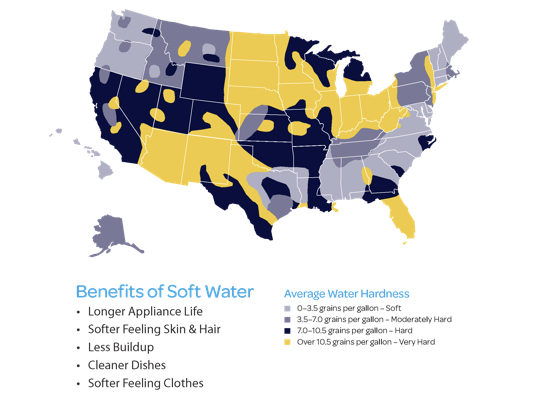Learn More
Benefits of Soft Water
- It Saves Money
- Helps Avoid Scale Build Up
- Prevents Rust Stains
- Reduces Water Spots
- Improves Rough, Dry Skin
- Increases Lathering of Soaps
- Increases Life of Appliances
- Improves Taste and Eliminates Odor
Advantages of our Products
- Quick and Easy Regeneration
- Compact & Easy to Use
- 8,000 Grain Capacity (Standard)
- Compact, Space-Saver Design
- 16,000 Grain Capacity (Double Standard)
- Handles High-Flow Rates with Little Pressure Drop
- Inlet Flow Control
- Includes High-Grade Premium Capacity Resin
- Handle Included
- Large-Mouth Opening
- Cap and Plug for Storage
Capacity of a Water Softener
How many gallons a softener will approximately make depends on the hardness of the water source and your usage. To figure out the approximate capacity of your unit you take the grains of the unit (Standard 8,000/Double 16,000) and divide that by the gains per gallon (GPG) of the water source.
Standard Softener
8,000 / 11 GPG = 727 gallons
8,000 / 58 GPG = 137 gallons
Double Standard Softener
16,000 / 11 GPG = 1,454 gallons
16,000 / 58 GPG= 275 gallons
If you go to long before performing the regeneration process a few things may happen. Your unit may not last a long or after the regeneration process the strips will not test between 0-2 GPG at the output of the softener. This can easily be corrected by performing a special regeneration process.
Soft Water is a Great Investment
Ben Scherschel, On The Go Portable Water Softener, LLC
Water softening is reducing the concentration of calcium, magnesium, and other metal cationsin hard water. These “hardness ions” can cause a variety of undesired effects, including interfering with soaps, and the build-up of limescale, which can affect the life of appliances by causing rust stains, changing taste and odor, creating water spots, and causing rough, dry skin.
As avid RVers travel throughout the U.S., they will discover that several camp grounds and RV parks have hard water. Furthermore, the Sun Belt states such as Florida, Louisiana, Texas, Arizona, New Mexico and California can have "extremely" hard water. With more than 8 million RVs in the U.S. today, and more than 200,000 RVs made each year, most RVers don't realize they are damaging their investment with hard water. Sinks, toilets, and showers with hard water damage can make it difficult to resell an RV, and hard water will greatly reduce the life of hot water heaters. RVers are also denied the advantages that soft water provides for consumption (and their coffee every morning!).
So, what makes water hard?
The words "hard water" describe water that contains calcium and magnesium, the hardness minerals. Rain water begins as soft water, which is free of these hard minerals. As rain water passes over and through the earth, flowing into lakes, rivers, streams, and ground water, it absorbs hardness minerals. While these minerals aren't harmful to your health, they affect the properties of water, and its effectiveness for washing and cleaning.
Although water hardness usually measures only the total concentrations of calcium and magnesium (the two most prevalent divalent metal ions), iron, aluminum, and manganese can also be present at elevated levels in some locations. The presence of iron characteristically confers a brownish (rust-like) color to the calcification instead of white (the color of most of the other compounds).
Water hardness is typically measured in GPG [grains per gallon] or PPM [parts per million]. Here is a table to illustrate various levels of hardness:
GPG PPM
Soft 0-3 0-60
Moderately hard 3-7 61-120
Hard 7-11 121-180
Very hard 11 greater then 181
More than 85% of American homes have hard water.[1]The softest waters occur in parts of the South Atlantic-Gulf, Pacific Northwest, New England, and Hawaiian regions. Moderately, hard waters are common in many of the rivers of the Tennessee, Great Lakes, and Alaska regions. Hard and very hard waters are found in some of the streams in most of the regions throughout the country. The hardest waters (greater than 1,000 PPM) are in streams in Texas, New Mexico, Kansas, Arizona, and southern California.[2]
Total Hardness test strips for water quality are the ideal solution to measure “water hardness.” Total Hardness test strips are perfect for measuring the water source to help determine capacity, outlet water flow, softness, and performance of the water softener. They offer a wide range of detection and are calibrated to be accurate and sensitive. With their low cost and high accuracy, Total Hardness test strips also save your customers time and money. No more counting drops or waiting for laboratory results, and levels can be determined in just a few seconds.
The ion exchange process requires salt to be added periodically to the softener unit, a step called "regeneration.” Every softener should also include a back-flushing to maintain the performance of the unit.
Selecting a portable water softener:
Many factors should be considered when purchasing a water softener for an RV:
- Capacity and Weight
- The most compact softener is typically about 8,000 grain capacity and weighs about 18 lbs.
- The largest compact model will have about 16,000 grains and may weigh about 30 lbs.
- Exchange Resin
- Only softeners with high grade premium exchange resin should be considered
- Color of resins will not indicate quality
- Easy Access for Regeneration
- Large mouth opening allows easy filling of the salt
- Accessories
- Carrying handle
- Inlet flow control for easy regeneration
- Storage/transportation adapters to eliminate water spillage
- Sturdy, stable base
Portable water softeners are incredibly important for an RV because they help prevent rust buildup, soap scum, water spots, and dry skin. Using a water filter is an added bonus, as it removes sulfides and other particles that give water a bad flavor or odor. However, filters are only effective for small volumes of water and do not dissolve minerals such as iron, calcium, and magnesium. A water softener will ensure that an RV’s pipes and appliances will remain stain and clog-free, requiring less maintenance and repair in the long run. Soft water SAVES MONEY by protecting your RV investment. Additionally, without soft water, you would be denied the advantages that soft water provides for consumption by reducing those harmful minerals that cause bad tastes and odors.
Why do I need a water softener? A water softener removes harmful minerals from supply water therefore extending the life of plumbing fixtures and appliances. It also helps cut down on soap, shampoo, and detergent costs.
What does a water softener remove? A water softener removes calcium, magnesium, lime, and iron from supply water. By removing these minerals, you eliminate buildup in pipes, on fixtures, and in your RV water heater.
Is the water softener hard to regenerate? No, this unit regenerates with just a 1 pound box of table salt. You just shut off the water supply, unhook the outlet side of the water softener, twist off the tank cap, pour in the table salt, put the cap back on, turn on the water supply, rinse the unit for the recommend amount of time, and perform a fast rinse. This will complete the regeneration process.
Can the water softener be hooked up backwards? Yes, but don't worry. The On The Go Water Softener is manufactured so none of the resin can be lost. Inlets and outlets are conveniently marked for ease in installation.
Why use table salt instead of pellet salt? Table salt dissolves quicker than rock salt therefore it will rinse from the water softener easier and faster. If you want to use pellet salt please look into our Salt Dispenser.
Will my water taste salty? No, if the water softener is rinsed properly during regeneration.
What Salt Do I Need to Use? You will need everyday, ordinary table salt to regenerate the softener. You can purchase Morton salt, generic brands or store-name brands. You can use plain, iodized salt, or potassium chloride it doesn't matter!
How Does a Water Softener Work? The principle behind water softening is really just simple chemistry. A water softener contains resin beads which hold electrically charged ions. When hard water passes through the softener, calcium and magnesium ions are attracted to the charged resin beads. It's the resulting removal of calcium and magnesium ions that produces "soft water."
The idea behind how a water softener works is simple. The calcium and magnesium ions in the water are replaced with sodium ions. Since sodium does not precipitate out in pipes or react badly with soap, both of the problems of hard water are eliminated. To do the ion replacement, the water in the house runs through a bed of small plastic beads or water softener resin. The resin is covered with sodium ions. As the water flows past the sodium ions, they swap places with the calcium and magnesium ions. Eventually, the resin contain nothing but calcium and magnesium and no sodium, and at this point they stop softening the water. It is then time to regenerate the resin.
Regeneration involves soaking the resin in a stream of sodium ions. Salt sodium chloride, so the water softener mixes up a very strong brine solution and flushes it through resin (this is why you load up a water softener with salt). The strong brine displaces all of the calcium and magnesium that has built up in the resin and replaces it again with sodium. The remaining brine plus all of the calcium and magnesium is flushed out.
How Long Does a Water Softener Last? The resin for our softeners have a life span of 7 to 10 years depending on the quality of water and the frequency of regeneration. When the old resin is replaced with new resin.
How Much Sodium is Added to Water? That depends on the hardness of the original water. This table shows the additional amount of sodium consumed by drinking one quart of softened water. Initial Hardness Sodium Added 1.0 grains per gallon 7.5 milligrams/quart 5.0 grains per gallon 37.5 milligrams/quart 10.0 grains per gallon 75.0 milligrams/quart 20.0 grains per gallon 150.0 milligrams/quart 40.0 grains per gallon 300.0 milligrams/quart As a comparison, one slice of white bread has 161 milligrams of sodium; 3/4 cup of canned baked beans = 1130 milligrams; 1 tablespoon of catsup = 204 milligrams; 1 medium frankfurter = 610 milligrams; and 1 cup of whole milk = 127 milligrams. Even a common Alka Seltzer tablet contains 532 milligrams of sodium. However, if you suffer from hypertension or are on a sodium restricted diet, you should consult your doctor about the proper water for drinking.
Sodium Related Health Issues. Potassium Chloride water softening salt are a sodium substitute for use in most water softeners. They have a low insolubility with up to 99.1% purity of the salt.
Are You in a Hard Water Area? Few things are harder on your family than hard water. It's hard on your clothes, your dishes, your pipes and your appliances. Fortunately, no one knows more about hard water and how to soften it than Morton® Salt. To find out more about hard water and how Morton can make your "hard" life a little easier, just select the topics from the menu below.

Source: Morton Salt



